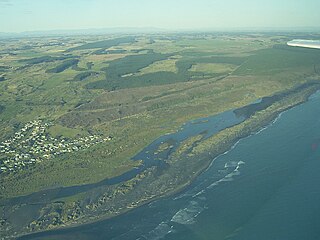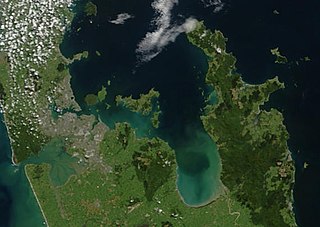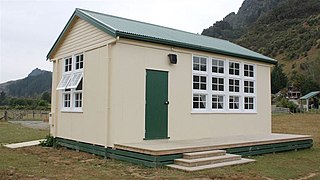The Whanganui campaign was a brief round of hostilities in the North Island of New Zealand as indigenous Māori fought British settlers and military forces in 1847. The campaign, which included a siege of the fledgling Whanganui settlement named "Petre", was among the earliest of the 19th century New Zealand Wars that were fought over issues of land and sovereignty.

Whanganui, also spelled Wanganui, is a city in the Manawatū-Whanganui region of New Zealand. The city is located on the west coast of the North Island at the mouth of the Whanganui River, New Zealand's longest navigable waterway. Whanganui is the 19th most-populous urban area in New Zealand and the second-most-populous in Manawatū-Whanganui, with a population of 42,300 as of June 2021.

Manawatū-Whanganui is a region in the lower half of the North Island of New Zealand, whose main population centres are the cities of Palmerston North and Whanganui. It is administered by the Manawatū-Whanganui Regional Council, which operates under the name Horizons Regional Council.

Taumarunui is a small town in the King Country of the central North Island of New Zealand. It is on an alluvial plain set within rugged terrain on the upper reaches of the Whanganui River, 65 km south of Te Kuiti and 55 km west of Turangi. It is under the jurisdiction of Ruapehu District and Manawatū-Whanganui region.

Rana Donald Waitai was a New Zealand politician and lawyer. He was a member of the New Zealand House of Representatives representing Te Puku o Te Whenua, for the New Zealand First Party and Mauri Pacific Party from 1996 to 1999. He later served as a member of the Wanganui District Council.

The Whanganui River is a major river in the North Island of New Zealand. It is the country's third-longest river, and has special status owing to its importance to the region's Māori people. In March 2017 it became the world's second natural resource to be given its own legal identity, with the rights, duties and liabilities of a legal person. The Whanganui Treaty settlement brought the longest-running litigation in New Zealand history to an end.

Moutoa Gardens, also known as Pākaitore, is a park in the city of Whanganui, New Zealand. Named after the Battle of Moutoa Island in the Second Taranaki War, it contains a memorial to the battle inscribed "To the memory of the brave men who fell at Moutoa, 14 May 1864, in defence of law and order against fanaticism and barbarism." It also contained a statue of John Ballance, organiser of a volunteer cavalry troop in Tītokowaru's War and later Premier of New Zealand, but the statue was beheaded and a replacement installed outside the district council building. A number of items present in the park are registered by Heritage New Zealand.

The Whanganui Chronicle is New Zealand's oldest newspaper. Based in Whanganui, it celebrated 160 years of publishing in September 2016. It is the main daily paper for the Whanganui, Ruapehu and Rangitīkei regions, including the towns of Pātea, Waverley, Whanganui, Bulls, Marton, Raetihi, Ohakune and National Park.

Pākaraka, previously known as, Okehu, Maxwelltown, and most recently Maxwell, is a farming and lifestyle community 20 kilometres (12 mi) west of Whanganui, on the North Island of New Zealand.

Ngāti Tama is a historic Māori iwi of present-day New Zealand which whakapapas back to Tama Ariki, the chief navigator on the Tokomaru waka. The iwi of Ngati Tama is located in north Taranaki around Poutama. The Mōhakatino river marks their northern boundary with the Tainui and Ngāti Maniapoto iwi. Titoki marks the southern boundary with Ngati Mutunga. The close geographical proximity of Tainui's Ngati Toa of Kawhia and Ngati Mutunga explains the long, continuous, and close relationship among the three Iwi.
Western Maori was one of New Zealand's four original parliamentary Māori electorates established in 1868, along with Northern Maori, Eastern Maori and Southern Maori. In 1996, with the introduction of MMP, the Maori electorates were updated, and Western Maori was replaced with the Te Tai Hauāuru and Te Puku O Te Whenua electorates.

Whanganui High School is a large state co-educational New Zealand secondary school located in Whanganui, New Zealand. Founded in 1958, the school has a roll of 1479 students, including international students as of July 2018, making it the largest school in Whanganui.
Matahiwi is a farming community 55 kilometres (34 mi) upriver from Whanganui, New Zealand, home to the Māori hapū known as Ngā Poutama of the iwi Te Āti Haunui-a-Pāpārangi. The township takes its name from the bush-clad puke (hill) on the western side of the Whanganui River, right above the local marae, whose name translates as "the face on the ridge".

The Kawana flour mill near Matahiwi was built in 1854, and is the last remaining flour mill on the Whanganui River and the only remaining 1850s mill machinery in New Zealand.

Koitiata is a settlement located in the southwestern part of Rangitikei District of the Manawatū-Whanganui region of New Zealand's North Island. At the time of the 2018 census, Koitiata had a population of 128. Marton is located 24 km to the east and Whanganui is located 29 km to the northwest. Nearby Koitiata is Lake Koitiata.

Marutūāhu, Marutūahu or Marutuahu is a collective of the Māori iwi (tribe) of the Hauraki region of New Zealand. The confederation is made up of the tribes of Ngāti Maru, Ngāti Paoa, Ngāti Tamaterā, Ngāti Whanaunga and Ngāti Rongoū.
Aramoho is a settlement on the Whanganui River, in the Whanganui District and Manawatū-Whanganui region of New Zealand's North Island. It is an outlying suburb of Whanganui.

Putiki is a settlement in the Whanganui District and Manawatū-Whanganui region of New Zealand's North Island, located across the Whanganui River from the Wanganui township. It includes the intersection of State Highway 3 and State Highway 4.

Whakahoro is a small settlement located south of Taumarunui on the junction of the Retaruke and Whanganui Rivers, about 104 mi (167 km) upstream from Whanganui. By gravel roads it is 41 km (25 mi) west of Raurimu and 44 km (27 mi) south west of Ōwhango.
Pura McGregor, also known as Pura Makarika, was a community leader in Whanganui, New Zealand, and the first Māori woman to receive an MBE. She was of Ngā Poutama, Ngāti Ruāka and Ngāti Rangi descent.
















